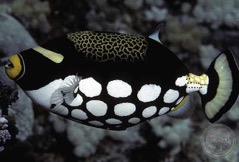Triggerfish Information
Triggerfish belong to the family Balistidae. Consisting of at least 40 different species, some of these carnivorous fish can grow up to 3.3 feet in length. They’re found only in tropical and subtropical oceans, as opposed to freshwater. The largest numbers are found in the Indo-Pacific, and their preferred habit is shallow waters along coral reefs. Triggerfish are oval in shape with a compressed body. Their eyes are far back on their head and can be moved individually. They have various patterns of lines and spots and a multitude of colors such as blue, yellow, white, black and gray. The name, triggerfish, comes from the set of moveable spines the fish uses for a locking system. When the larger forward spine is upright, the smaller spine behind it drops down to secure the first spine in place. This back spine is the aforementioned “trigger.” The spines help to both deter predators and anchor the triggerfish tightly into a hiding spot.
They’ll look for food likes crabs and worms hiding on the bottom by flapping away debris with their fins. They may also squirt water from their mouth to clear the sand away. Tough teeth and jaws allow them to consume even urchins if they are able to at least flip the echinoderm onto its back.

Triggerfish may also consume hard corals when eating other species. While digesting coral, they will eliminate this by-product as a white-trail in the water. It’s not unusual to see other fish following close behind these avid hunters for leftovers. Most triggerfish are solitary, although among some species a male may have a harem of females. These fish will congregate on common mating grounds, depending on the moon and tides, where the males establish territories. Both the male and female will care for the eggs until they hatch. Other than cooperating with mates when eggs have been laid, triggerfish are known for having a bad attitude. Some of these fish will even charge or bite at other fish and divers, especially around their nests.
Triggerfish do face the threat of overharvesting by humans because their appearance makes them popular for the aquarium trade. Fish bag limits and closed recreational harvesting months have been put in place for some species in response. For example, the gray triggerfish has stricter harvesting regulations in Gulf state waters than in Atlantic state waters. In Gulf state waters, only 1 gray triggerfish caught per person is allowed, and said fish must be at least 15 inches in fork length. A single person may catch up to 10 triggerfish in Atlantic state waters with only a minimum of 12 inches in fork length required. Gulf state waters also close harvesting entirely for this species during the months of January, February, June and July. There are a few threatened species of triggerfish that fishermen unfortunately have been found harvesting, further proving the pressure on these populations exists.
